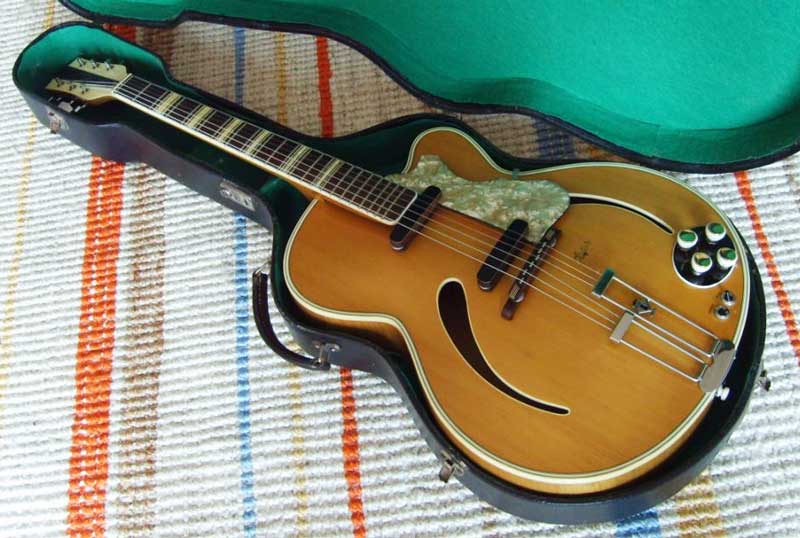
By the end of 1955, the definitive Hӧfner
archtop range was in place. A guitar for all tastes, aspirations, and most
importantly most pockets:
|
Model |
Date Introduced |
Nominal Body Size |
Finish
|
Body Timbers
|
Body Cutaway
|
Quality Rating |
Trade Price in 1954 |
|
449 |
1955/56 |
15” |
Brown Varnish |
Maple Laminates |
None |
Budget |
N/A |
|
450 |
1953 |
16” |
Brown Sunburst |
Maple Laminates |
None |
Budget |
134 |
|
455 |
1949 |
16” |
Red/Brown |
Maple Laminates |
None |
Budget |
152 |
|
4550 |
1954 |
17” |
Brown Sunburst |
Maple Laminates |
None |
Mid-Range |
168 |
|
456 |
1949 |
16” |
Brown Sunburst |
Maple Laminates |
None |
Mid-Range |
182 |
|
457 |
1952 |
16” |
Brown Sunburst |
Solid Spruce /Maple laminate |
None |
Mid-Range |
196 |
|
458 |
1954 |
16” |
Black |
Maple Laminates |
None |
Mid-Range |
184 |
|
459 |
1952 |
16” |
Natural Blonde |
Solid Spruce |
None |
Mid-Range |
230 |
|
460 |
1949 |
16” |
Black |
Solid Spruce / Maple lam’ate |
None |
Mid-Range |
234 |
|
461 |
1952 |
16” |
Black |
Solid Spruce /Maple lam’ate |
Cutaway |
High End |
320 |
|
462 |
1952 |
16” |
Natural |
Solid Spruce /Maple lam’ate |
Cutaway |
High End |
280 |
|
463 |
1949 |
16” |
Natural Blonde |
Solid Spruce/ |
None |
High-End |
288 |
|
464/S |
1953 |
16” |
Red Burst |
Solid Spruce /Maple lam’ate |
Cutaway |
High-End |
350 |
|
465 |
1949 |
16” |
Natural Blonde |
Solid Spruce |
None |
Luxury |
390 |
|
468 |
1953 |
17” |
Brown Sunburst |
Solid Spruce /Maple lam’ate |
With or without |
Luxury |
460/494 |
Initially, from 1949
through to around 1953, many of the archtops (but not all) were provided with
flared-top headstocks. Which models had this feature and which had symmetrical
“Gibson-style” headstocks seems to have been rather random, but the 1949 models
are more likely to have a flared headstock than the later ones. Perhaps the only
firm conclusion to be gained is that if you own a Hӧfner archtop with such a
feature, then it was almost certainly made between 1949 and 1953. After that
period, the symmetrical headstock seems to have been adopted for all models.
Another very attractive
feature on some of the early models is the split-strip fret-markers. These tend
to be actual mother of pearl inlays and can be seen on some of the very early
460, 461, and 463 models. Again, if you are lucky enough to own a guitar with
this feature, you can be fairly sure that it
was made sometime during the same 1949 to 1953 period.
The table above provides
information on the finishes applied to the first examples of each model. From
1954 onwards, starting with the 456 model, Hӧfner began to offer natural blonde
finishes as an alternative to the brown sunburst on most of the models. An extra
charge was made for this option, as slightly better quality laminates and
timbers were considered necessary.
Dark brown sunburst staining can be used to hide minor timber imperfections of course!
The trade price of a blonde 456 “b” model was 186DM; an increase of 4DM over the
price of the standard sunburst 456.
A similar type of option was provided for body
cutaways. As well as the three high-end quality guitars (the 461, 462, and 464)
only available with body cutaways, from 1954 onwards all other mid and high end
models from the 457 to the 465 could be ordered with body cutaways. This option
followed for the lower quality guitars over the following year or two. The only
exception was the budget-level 449, which was never offered with a body cutaway.
From this period onwards, Hӧfner adopted the designation “S” to be added to
those archtop model numbers provided with body cutaways. Hence, a 465 with
cutaway is described as a “465/S”.
The most important Hӧfner development in the
1950’s however was the introduction of built-in electrics on their guitars. The
US companies had been offering the facility of electrical amplification on their
archtop guitars since the mid-1930’s; the ES150 of 1936 being Gibson’s first
electric archtop. This had opened up a whole new sound and further potential use
for the archtop, and Hӧfner just had to get involved in this new style. Walter
Hӧfner threw himself into a sphere that was miles away from Hӧfner’s traditional
orchestral stringed instrument work back in Schönbach, but which he would very
quickly master and soon become a pioneer of himself.
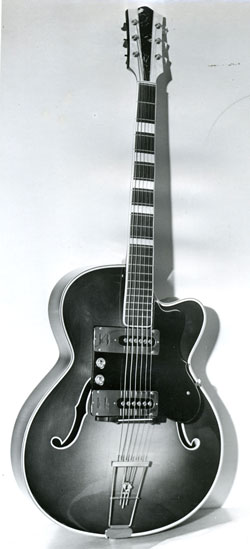 1954 Hӧfner 457/S/EA (catalogue illustration). |
To begin with, in 1954 Hӧfner
purchased screw-on pickup units from the Fuma Company in Berlin, and as
well as attaching these to a small number of guitars, also offered them
as accessories for owners to amplify their own acoustic guitars. The
457, being the real working player’s guitar, was chosen as the first
archtop to be offered factory-equipped with electrics. A “floating”
pickguard fitted with two Fuma single-coil pickups, complete with slide
volume and tone controls plus two toggle switches for selecting each
pickup output, was fitted to a 457/S. The resulting archtop appeared in
the 1954 catalogue as the “457/S/EA”, priced at 360 Deutchmarks. By the next year 1955, Hӧfner were offering several models with one (E1), two (E2), or three (E3) pickups mounted directly on the body tops, with simple round or oval volume/tone control consoles again body mounted and output jack sockets located on the lower body rim. The models so shown in the catalogue were the Hӧfner 457/S/E1, the 463/S/E2, and the 463/S/E3. Also shown was a Hӧfner 455/E which had a single “floating” Fuma pickup screwed to the end of the fingerboard. The price list for that year listed out prices for all four options to be fitted to any Hӧfner archtop to special order. All the electric guitars in the 1955 catalogue are shown as being fitted with Fuma metal-cased pickups, except for the 463/S/E3. This shows for the first time the Hӧfner "Bar" pickup, a simple single coil unit fitted into a slim rosewood case with a black plastic cap covering the tops of the five, yes five, pole-piece magnets. These units had been designed and developed by Walter Hӧfner himself to be made by his own craftsmen, hence the use of rosewood - a material that the Hӧfner workers would have felt confident with. Walter would soon have realised that there was little point in paying Fuma to supply something that his own people could produce at considerably less cost. The idea of just five pole-pieces for a six string guitar was intended to even-out the louder response of the guitar’s second string. Simple but it worked! |
 |
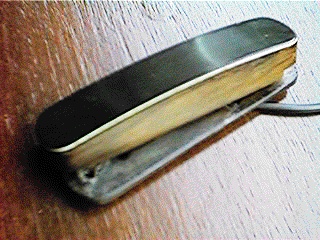 Early Hӧfner-made "Bar" Pickups with Rosewood case. |
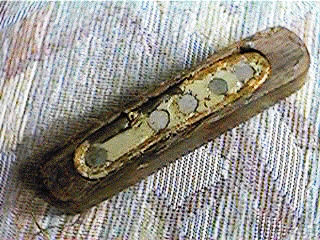 Early Hӧfner-made "Bar" Pickups with Rosewood case - showing 5 No Polepieces |
Over the next year or
so, the rosewood bar pickups would take the place of the Fuma units, which from
then on seem only to have been used very occasionally, presumably when the
production of the Hӧfner units could not keep pace with the orders for electric
guitars. This problem was solved eventually by Hӧfner sub-contracting their
pickups to the local company of Rinke in the nearby town of Erlangen. By 1958,
Franz Pix, Rinke’s former manager had set up a company himself to produce
pickups exclusively for Hӧfner, and at that stage the
pickup casings were changed to plastic.
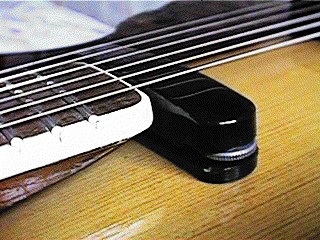 |
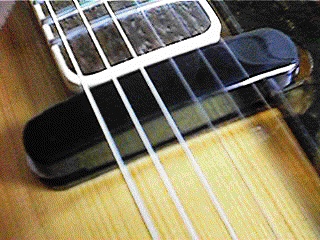 |
Photos of a later Franz Pix-made "Bar" Pickup.

c1957 Hӧfner 468/S/E1 fitted with a single
Pix-made "Bar" Pickup. The two control pots are mounted on a small circular
plastic console. The E2 versions with four control pots were mounted on a larger eliptical-shaped plastic console and directly adjacent two twin pole switches
for each pickup.
One more problem, all be
it minor, was left for Walter to ponder upon. The wiring up of the control
consoles, particularly those with the separately mounted pickup selector
switches, was also proving time consuming in the workshops. Walter’s men weren’t
electricians after all! By 1958, Walter had the answer. He designed a neat
rectangular control console that incorporated two volume controls, two slide
switches for pickup selection, and a solo/rhythm switch. A similar unit with
just one volume control and the slide switches used with capacitors for tone
modification was also designed. The idea was that the consoles could be also
made by his new subcontractor Franz Pix in Erlangen, complete
with a ready-soldered output socket and cable. Walter’s luthiers would only have
to solder the pickup leads onto the console and then screw the unit into a
routing in the top of the single or twin pickup guitars. For the much less
numerous three pickup orders, a separate body-mounted four-way selector had
to be used to handle that number of pickups, but even so the soldering work had
still been reduced. The consoles looked neat and modern, so that would also be a
sales attraction. They began to be fitted to the guitars from mid-1958 onwards.
A 1959 Hӧfner 461/S/E3, fitted with a pickup
built in to the end of the fingerboard. The white "Bar" pickups are very rare,
only being fitted to a small number of archtops in 1959/60. The
rectangular control console was introduced in mid-1958.
Walter had by now developed quite a fascination
for all things electronic, and at the 1957 Frankfurt Trade Show, he displayed
his latest invention – a hidden pickup mounted within a routing at the end of an
archtop’s fingerboard. As well as retaining the un-cluttered aesthetics of a
traditional acoustic archtop guitar, this also avoided the mounting of a pickup
directly onto the body top or table of the guitar with the resulting adverse
effect on the table’s resonance. Unfortunately, this idea did not really take
off with the players, and Hӧfner archtops fitted with these pickups are very
rarely seen nowadays.
By the end of the
1950’s, Walter was considering the possibility of active electronics for
electric guitars. In 1958 he introduced
what must surely be the very first pre-amp to be mounted in a guitar in order to
boost the output and enhance the sound from that guitar. The 1958/59 catalogue
shows a twin pickup 463/S archtop and
a single pickup 4570/S Thinline archtop,
each fitted with a battery powered pre-amp. This feature was offered
on any Hӧfner electric archtop. As usual, Hӧfner insisted on designating this
new feature as part of the model number system, and hence a 457 cutaway bodied
guitar with one, two, or three pickups and preamp fitted would be designated
457/S/T1, 457/S/T2, or 457/S/T3. This first foray in active guitar circuits was
to be followed over the next decade by many other circuit options, including,
treble boosts, vibrato effects, fuzz generators, and even a finger-controlled
wah-wah!
1958/59 Hӧfner
455/S/T1 with chicken-head control for the pre-amp mounted adjacent to the
rectangular console.
Before the war, Hӧfner in Schönbach had been
involved in the export of considerable numbers of double basses to the United
States to help fuel the Swing/Big Band style of music that became very popular
over in that country. The traditional way of making a double bass as far as the
luthiers of Schönbach were concerned was to carve the top table, back, and rims
from solid timbers. That was expensive but very necessary to satisfy
professional classical musicians.
However, was it really necessary for loud popular bandstand music? Walter Hӧfner
back then had thought not, and had therefore proceeded to develop the necessary
presses and molds for making double bass bodies from laminated timber. The
moulds for the basses were actually made from concrete in order to achieve the
necessary rigidity involved in pressing such large components.
All the archtop guitar
backs and rims were made from pressed laminates, together with the maple tops of
the cheaper models such as the 449,
450,
455,
4550, 456, and 458 when Hӧfner commenced production again initially at Mӧhrendorf
and then three years later at Bubenreuth. The better quality guitars all had
carved solid spruce body tops. With the coming of electrical amplification for
archtop guitars and the consequent reduced importance of such a guitars inherent
acoustic tone, it was inevitable that thought would be given as to whether the
use of finely gauged carved solid spruce tables in such instruments was really
necessary.
Solid spruce body tops are expensive and
time-consuming to carve, and also they can easily split in inclement climates or
with general miss-use. It seems obvious that at some stage, perhaps from say
1956/57 onwards, Walter had taken the decision to use laminated spruce tops for
at least those electric archtops that had been previously fitted with solid.
Certainly, the use of laminated tops on the mid/high-end/luxury electric
versions seems to have commenced from that date, with just about all electrics
(but not all) after 1960 having laminated tops. However, something similar but
to a much lesser degree also seems to have taken place with the acoustic
archtops. It would seem that a degree of confusion and disorganisation seems to
have descended on the Bubenreuth luthiers throughout this period, with in some
cases carved tops fitted to electrics and laminated tops to acoustics. Perhaps
this was due to problems in the guys assembling the guitars not being able to
identify which were solid and which were laminated top bodies before commencing
to rout out for control consoles etc. After the first cut was made and a solid
top discovered, it would then be too late and another electric archtop would
leave with a solid carved table! Whatever, by the mid-1960’s, all the definitive
Hӧfner archtops listed above, electric and acoustic, seem to have laminated body
tops. The only exception occurred in 1988 when Hӧfner pronounced that all future
470 models produced would return to having a solid carved spruce body top.
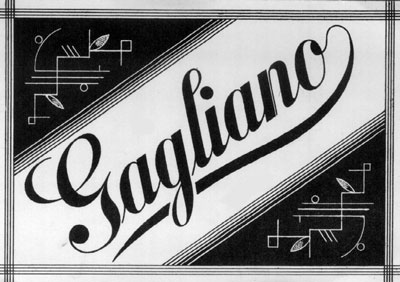
During the 1950’s and
well into the 1960’s, Hӧfner produced some archtops with the
logo “Gagliano” on the headstock or body. Other than this logo, those guitars
are exactly the same as their corresponding Hӧfner models. They all appear to
have been shipped to the United States. Gagliano is the name of a town in Italy
and also that of a very famous violin making family who lived in Italy However, there
was no such guitar manufacturer called Gagliano, and no retailer to the best of
my knowledge has traded under that name of Gagliano. So, what was going on?
Well, firstly I think that we have to go back to
days immediately after World War Two, when Josef Hӧfner and the people of
Schönbach were greatly helped by Mr Peterson of the Wm. Gratz Company of New
York. It may well have been the Hӧfner family’s wish to thank Mr Peterson for
that help but regardless of the actual details, it is clear that when Josef and
Walter re-formed the business, they decided to bestow the Gratz Company with the
exclusive rights to use the Hӧfner name in the US. That meant that all shipments
of goods with the Hӧfner name on them passing through US ports had to be
delivered to Wm. Gratz, or be denied entry into the US.
Before the War, the Hӧfner Company had many
other customers throughout the US, and as Josef built up the export business
again, those customers would obviously have wished to trade with Hӧfner once
again in order to help satisfy the post-war boom for musical instruments in the
US. These were old loyal customers, but nonetheless Josef would still have had
the embarrassment of asking them to purchase all Hofner goods through their
competitor’s company i.e. Wm. Gratz.
One such company was probably the established
stringed-instrument wholesaler based in New Jersey called the C. Meisel Music
Co. Inc. who bought in guitars and orchestral stringed instruments made in
particular by German manufacturers. The tradename they sold these guitars under
was “Gagliano”. Whether the fact that a different trade name was on the
headstock of these guitars, hence enabling them to be imported direct to Meisel,
or whether in fact the Gagliano guitars were still handled by Gratz is not
known.

________________________________________________
All Text is Copyright
© 2022 Steve Russell. All Rights Reserved